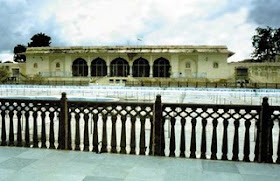World Widest Concrete Building in Jaipur India World Record
The city-based firm N.M. Roof Designers (NMRD) Ltd has figured in the Guinness Book of World Records for designing and constructing a 'satsang hall' (prayer hall) in Jaipur, which has a reinforced concrete cement (RCC) flat roof with a single span of 119 feet.
'If Dubai has Burj Al Hotel - the world's tallest tower - India now has Govind Devji's Satsang Hall in Jaipur, the world's widest concrete building,' said Deepak Sogani, CEO of NMRD Ltd, the structural consultants and contractors for this project, at a press conference here Wednesday.
The building is owned by the Govind Devji Temple Trust. The trust awarded the project to the Rajasthan State Road Development Corporation (RSRDC), which in turn roped in Deepak Sogani and NMRD for structural designing and construction of the hall. The architectural services were provided by architect Rajeev Khanna of Delhi.'It is a great moment of pride for NMRD, RSRDC, state of Rajasthan as well as for India to figure in the Guinness World Records for this architectural wonder,' Sogani added.
The total cost of building this structure was Rs.30 million (Rs.3 crore).The hall is adjacent to the Govind Devji Temple, the personal temple of the royal family of Jaipur. The hall is situated in the City Palace complex - the residence of the maharaja - in the old walled city.The Govind Devji Temple Trust wanted a satsang hall that could seat 5,000 devotees at any given time. The primary requirement of the trust was that the hall should not have any pillars in between.
Given the large width of the hall and the requirement of constructing a flat, usable roof, the only structure that could work was a grid slab. A grid or waffle slab is an RCC roof constructed employing a criss-cross square grid of deep ribs.The entire grid roof of 36 metres x 38 metres is resting on four peripheral beams. The outer beams, in turn, rest on eight columns on the outer periphery, four at the corners and four in the middle of each side.
'We faced several engineering challenges while designing a structure of this size. Our major concern was to minimize the deflection, or the sagging of the roof - a phenomenon that occurs when pillars are distant from each other,' Sogani said.An innovative idea struck Sogani. By increasing the thickness of a very insignificant slab from 115 mm to 200 mm, the deflection was brought within permissible limits. 'This was a magical moment in my 26-year long structural engineering career,' Sogani said.
Further, Sogani went to Britain to get trained in the world's latest technology in building construction - post-tensioning.Both the post-tensioning technology and the increase in slab thickness contributed to creating this structural marvel.'We used equipment and technology deployed for making flyovers and bridges to construct this hall,' he added.'The location of the hall was another challenge. The construction of the roof required 90 trucks to enter the busy site during a period of 36 hours,' Sogani said.
This busy tourist destination also attracts roughly 2,000 devotees that visit the temple every day, apart from the city crowds.'Help came from everywhere,' Sogani said.The Jaipur traffic police offered to control the traffic for smooth movement of trucks. RSRDC personnel and temple workers helped with the logistics during the period of roof casting.Giving details, Sogani said the prayer hall's roof area is about 16,000 square feet and a total of two million (20 lakh) litres of concrete was used to build this hall.The hall has been constructed using three lakh kg of steel. This quantity of steel could have built 60 residential flats.

